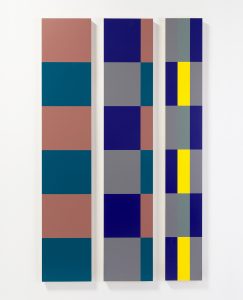
Harmony and Contrast: Chromatic Painting at the Turn of the Century
by Jacob Cartwright
May 12, 2022
Published to accompany the exhibition
HARMONY AND CONTRAST: Chromatic Painting at the Turn of the Century
presented by TRANSMITTER, Brooklyn, NY, May 14–June 19, 2022
Featuring works by:
Siri Berg, Gabriele Evertz, Daniel G. Hill, and Vincent Longo
Exhibition curated by Jacob Cartwright and Rob de Oude
Image: Daniel G. Hill , #9407, 1994; acrylic on canvas, 72 × 44 in, courtesy of the artist
(view enlarged)
“If we look simultaneously upon two stripes of different tones of the same color… as these modifications make the stripes appear different from what they really are, I give to them the name of simultaneous contrasts of colors.”
“[This ‘magic’] is to be found in the flat tints of house-painters generally in a more marked manner than in the pictures of the great colorists, because the latter in many cases soften the separation of two colors by blending them together.”
The Principles of Harmony and Contrast of Colors and Their Application to the Arts
—Michel Eugène Chevreul, 1860
In the early 1990’s there was an uptick in exhibitions devoted to abstract painting in New York City galleries. The development was noted as a move away from the neo-expressionist figuration that had dominated the painting scene of the 1980’s. Some of the poststructuralist trappings of 1980’s abstraction persisted, but Peter Halley’s heady interpretations of French theory (“The Crisis in Geometry”)1 had given way to the more sly and relaxed postmodernism of painters like Jonathan Lasker. Abstract painting also began to absorb influences from outside the medium, exemplified by work such as Polly Apfelbaum’s “fallen paintings”, which took a cue from the site-specificity of installation art, and were arrayed on gallery floors.
As the decade advanced towards the turn of the century, notions of “globalism” made more frequent appearances and critics, not without some frustration, observed that painting and the artworld overall had taken on a kind of sprawl—Roberta Smith, reviewing a survey exhibition at the Whitney Museum in 1996, referred to the art of the era as “obdurately pluralist”.2
As much as this “pluralism” may have stymied the desire for tidy critical analysis, it allowed artists and curators to explore areas of interest without a need to shoehorn them within a dominant critical narrative. This critical environment offered non-objective painting a possibility that had been largely denied with the erosion of modernism: the opportunity to unapologetically engage viewers in terms of pure visual sensation.
The 1999 exhibition Post-Hypnotic, curated by Barry Blinderman as a survey of the persistence of Op-Art’s influence, is a clear example of this. The show’s chronology began with artists like Philip Taaffe and Ross Bleckner who used certain conceptual modes—broadly designated as Neo-Geo—as a means of revisiting pure opticality in painting. The bulk of that exhibition was then devoted to painters who came to prominence in the 90’s—artists such as Karen Davie, Tom Martinelli, Michelle Grabner, Michael Scott and Susie Rosmarin—who were pursuing an approach to perceptual painting that was guided more by their own artistic viewpoint than the dictates of a particular theoretical zeitgeist.
It is in a similar spirit that we present this exhibition, which situates itself within this historic context, and explores a particular vein of non-objective painting in the period. Specifically, this show focuses on painters who were utilizing systems of their own devising to distribute flat color, and thus organize complex color relationships. This grouping of artists isn’t intended to imply a school or a scene, but rather four artists who were working outside of dominant paradigms, yet developing related ideas about color systems, in and around New York City near the turn of the century.
This selection of non-objective multicolor paintings from the period focuses on artists who employed a method which can be described by a phrase borrowed from Michel-Eugène Chevreul: simultaneous color contrast. This phraseology refers to the way that neighboring colors influence their respective appearances—yielding harmony and contrast. Josef Albers’ Interaction of Color3 is the canonical modernist touchpoint here, and there is a direct lineage: Albers was an early member of American Abstract Artists, the New York City artist group founded in 1936, which over time has included all of the artists in the exhibition as active members.
Our exhibition aims to demonstrate how these artists expanded upon the analytical approach to organizing color developed by forbearers like Albers. Recognizing the rich vocabulary of color relationships, all of these artists sought to develop their own approaches to this kind of visual syntax.

Japanese woodblock print collage, 37 x 87 in
© 2022 Estate of Siri Berg / Artists Rights Society (ARS), New York
Siri Berg’s Straight Line–Diptych, a collage made from individually woodblock printed sheets of solid color, is an outlier in the exhibition insofar as it isn’t technically a painting. Nevertheless, resting in a hybrid space between mediums, it brings to the fore the concerns that make up the foundation of this show: the organization of color via materiality. In her formative years as an artist, Berg delved into the Kabbalah and its principles which guide the movement between the metaphysical and the physical realm—this body of Berg’s work is arguably her most elegant expression of the interplay between material and immaterial elements. The diptych is at once a strictly serial chromatic progression, while at the same time exploiting the interaction between veils of transparent color, the imprints of woodgrain, and the variegated surface of handmade paper. The result is a remarkably nuanced play between pure color and the textures of the physical world.
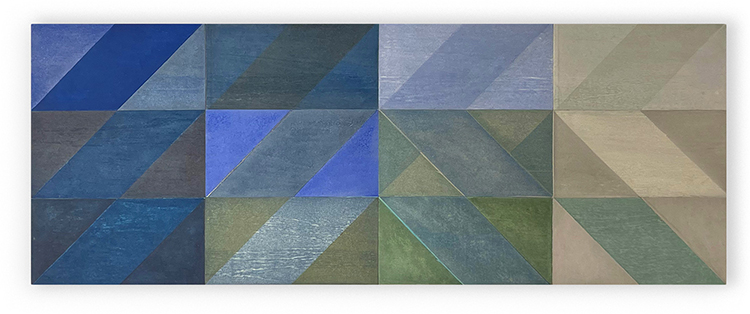
Japanese woodblock print collage, 22 ⅜ x 51 ¾ in
© 2022 Estate of Siri Berg / Artists Rights Society (ARS), New York
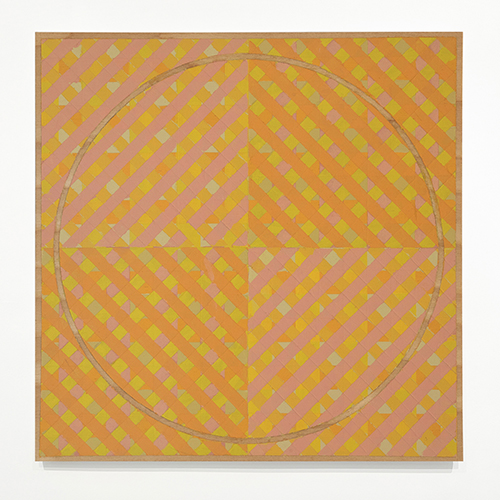
acrylic on canvas, 9 x 9 in
Courtesy The Drawing Room
Vincent Longo’s paintings express old world sensibilities. While he can be counted among the great number of modern painters who worked from an underlying grid, he always observed that his methods owed as much to mandalas as they did to Mondrian. His paintings are unmistakably concerned with using color as a way to create an atmosphere of disembodied light, engaging with the poetry of individual experience and sensation. His arrangements of close-valued color are sensitively balanced; the intuitive approach to their making speaks to the subjective nature of experience. Despite their rectilinear framework, the paintings imply color suspended within a fog of light and, as such, his achievements could be regarded as being in line with JMW Turner and Mark Rothko.
Longo once remarked “All artists use color in personal terms. I try to stretch its common usage—being a matter of taste or embellishment—and try to think of it as having its own space and atmospheric presence to affect the tone and formal conditions of the work—almost requiring primary attention.”
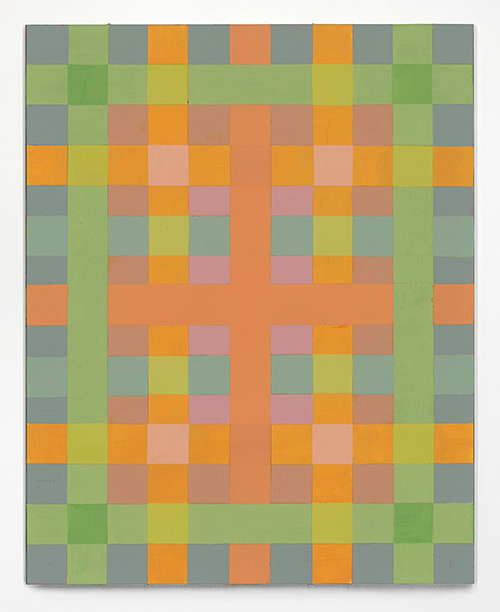
acrylic on masonite, 10 x 8 in
Courtesy the collection of Mary Schiliro
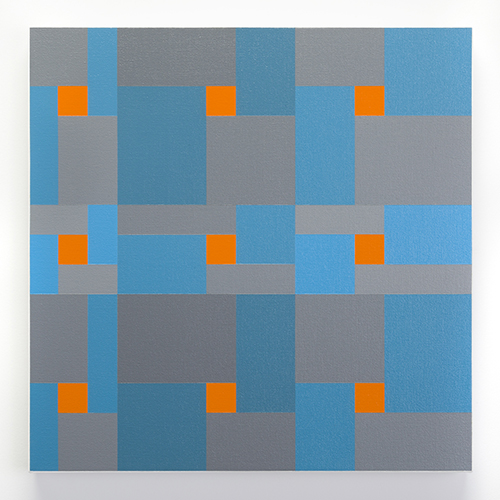
acrylic on canvas, 15 × 15 in
Courtesy the artist
Daniel G. Hill has, over the course of his career, developed a body of sculptural work that is distinguished by its elegant distillation of materials and structural form. Outwardly, the color paintings he made from the mid 1980’s through the early 2000’s may seem like an anomaly, situated as they are within a body of reductive sculptural work where color has been largely excised. Upon closer examination, his paintings are of a piece with his broader concerns—specifically, they demonstrate a devotion to internal logic as the organizing principle of an artwork. Hill observes that his paintings ultimately reaffirmed his position as a sculptor because their use of color and pattern was a fundamentally structural approach. Hill’s paintings are, in their essence, studies in the way that pattern can yield variation. By overlaying two rectilinear patterns, and bounding the resulting third pattern in such a way that it never repeats within the painting’s borders, the works represent structural units. Hill’s use of color adheres to its own form of phenomenological reasoning, with complementary color decisions often being based on direct observation of an adjoining color’s retinal afterimage.
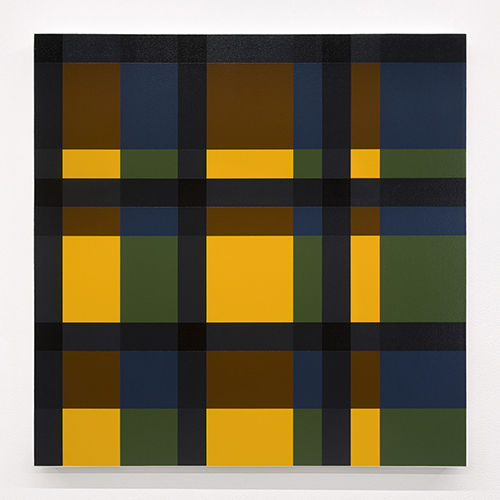
acrylic on canvas, 30 × 30 in
Courtesy the artist

acrylic on canvas, 72 × 72 in
Courtesy the artist
Gabriele Evertz should be regarded among the foremost color painters of our day. While she is routinely associated with a “Hunter Color School”—given her career with Hunter College—she is quick to observe that, in the 1990’s, she was developing her own concepts independently in her studio on Long Island. The selections for this show offer an illuminating snapshot, presenting her earlier work alongside a formative example of her current working methods. Her work from 1998 presents high-key color contrast with side-by-side color; the work is at once energetic while still displaying a studied approach to color relationships. Her work from 2003 demonstrates her increasing ability to achieve nuance within color interaction. This small work introduces her signature motif of attenuated triangles that, while reading as vertical stripes, serves as a means of transitioning distinct color relationships across the top and the bottom of the canvas. It’s a unique feature of Evertz’s practice that she strictly uses paint straight from the manufacturer, relying purely on optical mixing of neighboring colors and, in so doing, emphasizing the role of the viewer in her work.
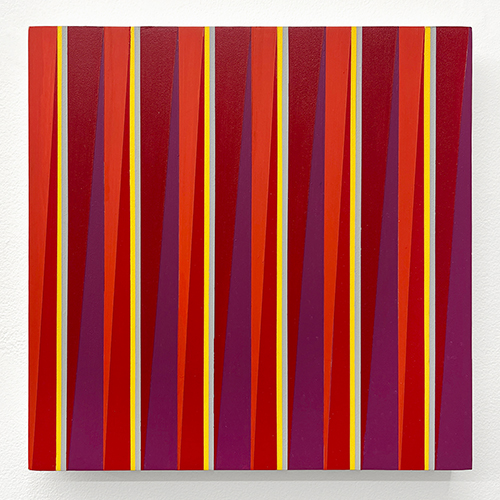
acrylic on wood, 12 × 12 in
Courtesy the artist
This show has been consciously organized to reflect the intergenerational aspect of artistic ideas and influence. All of these artists have worked dedicatedly as professors of art in the New York City area, meaning that their ideas have been communicated not just via their art, but through their pedagogical roles as well. In keeping with this spirit, the selection of artists reflects the dynamic of collegial mentorship.
As the American Abstract Artists organization moves nearer to its centennial, this is arguably one of the primary functions that the group now serves: to foster affinities and dialogue between artists across multiple generations and, ultimately, the keeping of a flame.
While this exhibition is focused within a certain time and place, the chromatic impulse in painting is a perennial one that endures outside of dominant trends and frameworks. It is our hope that, by examining these earlier contributions to this throughline, these works will guide contemporary practitioners, both today and tomorrow.
Jacob Cartwright
New York City
May 2022
1 The Crisis in Geometry by Peter Halley, Published in Arts Magazine, New York Vol. 58, No. 10, June 1984.
2 From Ashcan to Pluralism, With No Pollock in Between by Roberta Smith, Published in The New York Times, April 12 1996
3 The Interaction of Color by Josef Albers, Published by Yale University Press, 1963
Artists’ Biographies

Siri Berg (Swedish American, 1921–2020)
Born in Stockholm, Siri Berg attended The Institute of Art and Architecture at the University of Brussels before immigrating to the United States at the age of 19. Berg worked briefly in interior design until she began pursuing her true lifelong calling: painting and color. In the 1980’s she moved to a loft in SoHo, where she lived and worked for the rest of her life. Berg taught Color Theory at Parsons School of Design for over 30 years and retired at age 91.

Vincent Longo (American, 1923–2017)
Vincent Longo studied at The Cooper Union and the Brooklyn Museum School. He began exhibiting in 1949 and in 1951 he received a Fulbright grant which he used to travel to Italy. Longo is equally acclaimed as both a printmaker and painter and he considered them to be equal practices that informed each other. He taught at Bennington College (1957-67) and taught painting and printmaking for 35 years (1967-2001) at Hunter College.
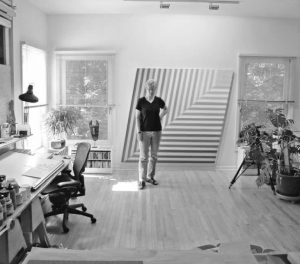
Gabriele Evertz (German American, b. 1945)
Gabriele Evertz was born in Berlin and moved to the U.S. as a teen. She holds an MFA in Painting and a BA in Art History, both from Hunter College. In addition to her painting practice, Evertz has curated and co-curated critically acclaimed artist retrospectives and surveys of abstract painting. She has also authored a number of catalog essays on the experience of color in abstract painting. Evertz was a Professor of Art and Painting in Hunter College’s Department of Art & Art History for 28 years (1990-2018), where she is a Professor Emerita.

Daniel G. Hill (American, b. 1956)
Daniel Hill holds an AB, Magna cum Laude from Brown University and an MFA from Hunter College. He is a multi-disciplinary artist who has worked in sculpture, installation, painting, photography, and digital media. He is the recipient of a fellowship in painting from the NEA and was awarded two year–long residencies at PS122 in New York City. Since 1985, he has held teaching positions at The College of the Holy Cross, Hunter College, Princeton University, and, since 1995, at the Parsons School of Design.
The Curators
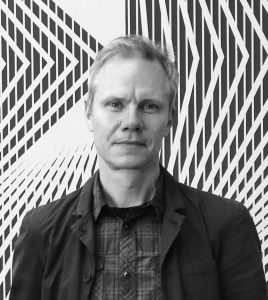
Rob de Oude (Dutch, b. 1970)
Rob de Oude studied painting, sculpture, and art history at the Hoge School voor de Kunsten in Amsterdam and attended graduate school at SUNY Purchase, NY. He is based in Bushwick, Brooklyn and active as a painter and curator. He is a co-founder of Transmitter Gallery, as well as the founder of former Brooklyn artist-run-galleries Camel Art Space and Parallel Art Space. His work is represented by McKenzie Fine Art.
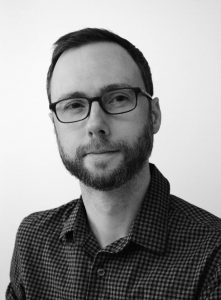
Jacob Cartwright (American, b. 1977)
Jacob Cartwright is an artist, curator, and writer based in New York City. He holds a BFA in Painting from the Kansas City Art Institute. Recent curatorial work includes New York is Now, presented with IS-projects in Athens, Greece. He recently initiated an ongoing series of curatorial essays for the AAA Online Journal—hosted on the American Abstract Artists website—with which this exhibition is presented in partnership.
